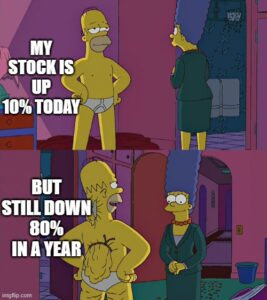What is a dead cat bounce, how can you identify one and which 5 stocks are in the midst of them?

The term dead cat bounce has gained popularity in recent years. And there have been plenty of examples of this phenomenon on the ASX. So, we thought we’d write an article to explore what exactly is a dead cat bounce in relation to stock investing.
What are the Best ASX Stocks to invest in right now?
Check our ASX stock buy/sell tips
What is a dead cat bounce?
The term “dead cat bounce” is often used to describe a temporary recovery in stock prices after a significant and prolonged decline. It implies that even a dead cat would bounce if it fell from a great height.
In other words, the stock may experience a brief uptrend before resuming its downward trend. This phenomenon is typically seen as a false signal of recovery and can often lead investors to make misguided investment decisions. They think a company is headed in the right direction now because of a temporary spike. However, it fell for a reason, and that reason may still be true.

How and why do they happen?
A dead cat bounce can occur for various reasons, such as short-covering or bargain hunting. Short-covering refers to when investors who have previously bet against the stock (short-sellers) close their positions, resulting in a temporary increase in the stock price.
On the other hand, bargain hunting occurs when investors see an opportunity to buy a stock at a lower price and believe it will eventually recover. If investors do get it right, they can make a significant profit. But if they buy in too early, they can join a very large club of people to have blown money on that stock.
Examples of dead cat bounces (in the market indices)
Some famous examples include the dot-com bubble burst in 2000, where many technology stocks experienced a temporary recovery before ultimately crashing again. Another notable example is the housing market crash of 2008, where financial stocks experienced a dead cat bounce before continuing their downward trend.
Other notable individual stock examples include Enron in 2001, General Electric in 2018, and more recently, Hertz in 2020. These companies all experienced significant declines in their stock prices and saw temporary uptrends before ultimately facing further decline.
It is essential to note that these are just a few examples, and there have been many more instances of dead cat bounces throughout the history of stock investing. Therefore, it is crucial for investors to stay vigilant and not rely solely on past events when making investment decisions. Instead, thorough research and analysis should always be the foundation of any investment strategy.
5 Examples of dead cat bounces on the ASX right now
WiseTech (ASX:WTC)
WiseTech shares roughly halved in 12 months but have rallied over 15% in the last 2 weeks. It has been to do with Richard White – the power struggle which he fought and ultimately won, then regulatory investigations over his share trading. Investor skepticism over the e2open acquisition did not help too. Shares have rallied in the last 2 weeks but little else has changed. In our view, a textbook potential dead cat bounce.
Bapcor (ASX:BAP)
Bapcor owns and operates outlets that sell vehicle parts and accessories, particularly Autobarn outlets. It has suffered due to weak consumer sentiment that has not faltered as well as continued inability to meet guidance in light of that. Bapcor is off all time lows, but at this current stage, any small uptick might just be technical bounce — unless business conditions improve meaningfully.
James Hardie (ASX:JHX)
James Hardie has had a difficult year on the ASX. As the supply chains for global housing markets struggle, it is doubling down as evident in its US$8bn+ buy of Azek. Australian investors hated how it did the deal without giving them the same vote Americans are getting and that it appears the company will eventually delist from the ASX be solely listed in America.
Ex-chair Anne Lloyd and a couple of other directors were dismissed by investors. While shares are up 16% in the past month, the stock has more than halved since February last year and the difficult construction market conditions show no sign of easing.
Nufarm (ASX:NUF)
Nufarm, an agricultural chemical supplier and manufacturer, has been slammed by lower commodity prices, Trump’s tariffs and adverse weather. Investors disliked both its half year and full year FY25 results which were severely impacted by those results. Shares rallied by up to 25% in November, but have more than halved in the last year.
CSL (ASX:CSL)
After so many years of growth, CSL has been through difficult times. It has not had the return on the US$11bn it put into buying Vifor, anti-vaccination sentiment is reducing the demand for vaccines, and the blood plasma product business has seen difficulty, particularly in China where government cost containment measures reduced the demand for its Albumin product. Arguably the compounding factor is the uncertainty over its future direction. It is down over 40% from its all time highs, and while it has not fallen further, any potential rally would in our view be a dead cat bounce.
The Risks Involved In Buying a Stock In a Dead Cat Bounce
While a dead cat bounce may seem like a positive sign for investors, there are significant risks involved. As mentioned earlier, it can lead to misguided investment decisions as some investors may see it as a sign of long-term recovery. However, the stock price may continue to decline after the temporary uptrend, causing losses for those who bought during the bounce.
How to Identify a Dead Cat Bounce
Identifying a dead cat bounce can be challenging, but there are some indicators that investors can look out for. One common indicator is heavy trading volume during the temporary uptrend, which suggests that short-sellers are covering their positions. There’s no hard and fast rule as to what is ‘heavy’ but it should be higher trading than usual – perhaps trading volumes significantly above the preceding 30-days average.
Additionally, investors should also pay attention to any news or events that may have caused the initial decline in stock prices. Are the catalysts that caused the decline all over, or just forgotten temporarily by investors? And is the reason the stock price rise a legitimate value-creator in the longer term?
Conclusion
A dead cat bounce is a term used to describe a temporary recovery in stock prices after a significant and prolonged decline. While it may seem like a positive sign for investors, it is crucial to understand the risks involved and not make hasty investment decisions based on this phenomenon.
As with any investment, thorough research and analysis are essential in making informed decisions. So, next time you come across the term “dead cat bounce”, remember to approach it with caution and carefully consider all factors before making any investment moves.
Blog Categories
Get Our Top 5 ASX Stocks for FY26
Recent Posts
Develop Global Wins $200m OceanaGold Contract- What It Means for Investors
Develop Global (ASX: DVP) climbed 4% to A$4.36 on Friday after securing a A$200 million underground development contract with global…
Nova Minerals Drops 14% on $20m Capital Raise- Buy or Avoid?
Nova Minerals (ASX: NVA) dropped nearly 14 per cent to A$0.90 following the announcement of a US$20 million (approximately AUD…
WiseTech (ASX:WTC) Rises After Richard White Cleared of Misconduct – Should You Buy the Dip?
WiseTech Global (ASX: WTC) climbed 3 per cent to A$70.18 on Friday after founder and Executive Chairman Richard White was…



